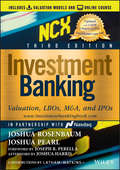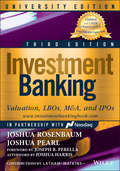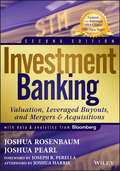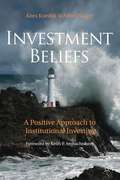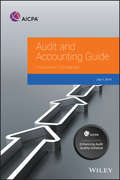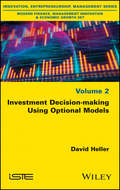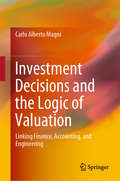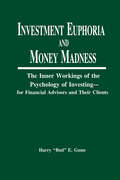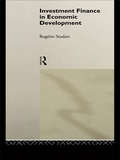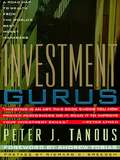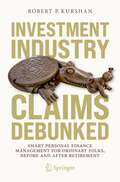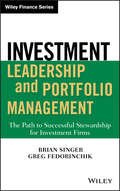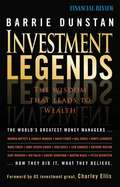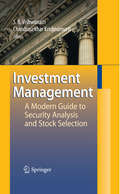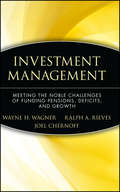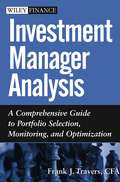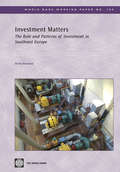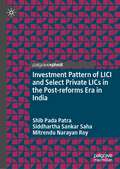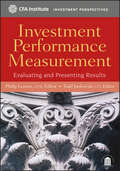- Table View
- List View
Investment Banking: Valuation, LBOs, M&A, and IPOs (Wiley Finance)
by Joshua Pearl Joshua RosenbaumA timely update to the global best-selling book on investment banking and valuation In the constantly evolving world of finance, a solid technical foundation is an essential tool for success. Due to the fast-paced nature of this world, however, no one was able to take the time to properly codify its lifeblood—namely, valuation and dealmaking. Rosenbaum and Pearl originally responded to this need in 2009 by writing the first edition of the book that they wish had existed when they were trying to break into Wall Street. Investment Banking: Valuation, LBOs, M&A, and IPOs, Third Edition is a highly accessible and authoritative book written by investment bankers that explains how to perform the valuation work and financial analysis at the core of Wall Street—comparable companies, precedent transactions, DCF, LBO, M&A analysis . . . and now IPO analytics and valuation. Using a step-by-step, how-to approach for each methodology, the authors build a chronological knowledge base and define key terms, financial concepts, and processes throughout the book. The genesis for the original book stemmed from the authors' personal experiences as students interviewing for investment banking positions. As they both independently went through the rigorous process, they realized that their classroom experiences were a step removed from how valuation and financial analysis were performed in real-world situations. Consequently, they created this book to provide a leg up to those individuals seeking or beginning careers on Wall Street—from students at undergraduate universities and graduate schools to "career changers" looking to break into finance. Now, over 10 years after the release of the first edition, the book is more relevant and topical than ever. It is used in over 200 universities globally and has become a go-to resource for investment banks, private equity, investment firms, and corporations undertaking M&A transactions, LBOs, IPOs, restructurings, and investment decisions. As the world of finance adjusts to the new normal of the post-Great Recession era, it merits revisiting the pillars of the second edition for today's environment. While the fundamentals haven't changed, the environment must adapt to changing market developments and conditions. As a result, Rosenbaum and Pearl have updated their widely adopted book accordingly, while adding two new chapters on IPOs.
Investment Banking: Valuation, LBOs, M&A, and IPOs (Wiley Finance)
by Joshua Pearl Joshua RosenbaumInvestment Banking Praise for Investment Banking, UNIVERSITY EDITION “This book will surely become an indispensable guide to the art of buyout and M&A valuation, for the experienced investment practitioner as well as for the non-professional seeking to learn the mysteries of valuation.” —David M. Rubenstein, Co-Founder and Co-Executive Chairman, The Carlyle Group Host, The David Rubenstein Show: Peer to Peer Conversations “The two Joshes present corporate finance in a broad, yet detailed framework for understanding valuation, balance sheets, and business combinations. As such, their book is an essential resource for understanding complex businesses and capital structures whether you are on the buy-side or sell-side.” —Mitchell R. Julis, Co-Chairman and Co-CEO, Canyon Partners, LLC “Investment Banking provides a highly practical and relevant guide to the valuation analysis at the core of investment banking, private equity, and corporate finance. Mastery of these essential skills is fundamental for any role in transaction-related finance. This book will become a fixture on every finance professional’s bookshelf.” —Thomas H. Lee, President, Lee Equity Partners, LLC Founder, Thomas H. Lee Capital Management, LLC “As a pioneer in public equities, Nasdaq is excited to be partnering with Rosenbaum and Pearl on Investment Banking as they break new ground on content related to IPOs, direct listings, and SPACs. We recommend the book for any shareholder and senior executive looking to take a company public, as well as their bankers and lawyers.” —Adena Friedman, President and CEO, Nasdaq “Investment Banking requires a skill set that combines both art and science. While numerous textbooks provide students with the core principles of financial economics, the rich institutional considerations that are essential on Wall Street are not well documented. This book represents an important step in filling this gap.” —Josh Lerner, Jacob H. Schiff Professor of Investment Banking, Harvard Business School Co-author, Venture Capital and Private Equity: A Casebook “Valuation is the key to any transaction. Investment Banking provides specific step-by-step valuation procedures for LBO and M&A transactions, with lots of diagrams and numerical examples.” —Roger G. Ibbotson, Professor in the Practice of Finance, Yale School of Management Chairman and CIO, Zebra Capital Management, LLC Founder, Ibbotson Associates “Investment Banking provides fresh insight and perspective to valuation analysis, the basis for every great trade and winning deal on Wall Street. The book is written from the perspective of practitioners, setting it apart from other texts.” —Gregory Zuckerman, Special Writer, The Wall Street Journal Author, The Greatest Trade Ever, The Frackers, and The Man Who Solved the Market Also available from the authors: Investment Banking WORKBOOK Investment Banking FOCUS NOTES Investment Banking ONLINE COURSE www.efficientlearning.com/investment-banking
Investment Banking: Valuation, Leveraged Buyouts, and Mergers and Acquisitions (Wiley Finance)
by Joshua Pearl Joshua RosenbaumThe No. 1 guide to investment banking and valuation methods, including online tools In the constantly evolving world of finance, a solid technical foundation is an essential tool for success. Until the welcomed arrival of authors Josh Rosenbaum and Josh Pearl, no one had taken the time to properly codify the lifeblood of the corporate financier's work-namely, valuation, through all of the essential lenses of an investment banker. With the release of Investment Banking, Second Edition: Valuation, Leveraged Buyouts, and Mergers & Acquisitions, Rosenbaum and Pearl once again have written the definitive book that they wish had existed when they were trying to break into Wall Street. The Second Edition includes both the technical valuation fundamentals as well as practical judgment skills and perspective to help guide the science. This book focuses on the primary valuation methodologies currently used on Wall Street: comparable companies analysis, precedent transactions analysis, discounted cash flow analysis, and leveraged buyout analysis. With the new fully revised edition, they have added the most comprehensive, rigorous set of intuition-building and problem-solving ancillaries anywhere all of which promised to become essential, knowledge enhancing tools for professionals, and professors and students. For those who purchase this edition of the book, there are options to purchase the Valuation Models separately (9781118586167), and to also consider purchase of the Investing Banking Workbook (9781118456118) and Investment Banking Focus Notes (9781118586082) for further self-study.
Investment Beliefs
by Kees Koedijk Alfred SlagerHaving the right investment beliefs and putting them into practice is key to delivering the right results. Decision makers in the investment industry should worry less about the stocks and products they pick for their clients and more about getting the big picture right; developing investment beliefs are instrumental in making the right choices.
Investment Biker
by Jim RogersLegendary investor Jim Rogers gives us his view of the world on a twenty-two-month, fifty-two-country motorcycle odyssey in his bestselling business/adventure book, Investment Biker, which has already sold more than 200,000 copies. Before you invest another dollar anywhere in the world (including the United States), read this book by the man Time magazine calls "the Indiana Jones of finance." Jim Rogers became a Wall Street legend when he co-founded the Quantum Fund. Investment Biker is the fascinating story of Rogers's global motorcycle journey/investing trip, with hardheaded advice on the current state and future direction of international economies that will guide and inspire investors interested in foreign markets.NOTE: This edition does not include a photo insert.
Investment Biker: Around The World With Jim Rogers
by Jim RogersThis book is about the author's amazing trip across six continents and the world economy and society. It discusses who's sinking and who's swimming, which countries are on the rise and which are collapsing, where you can make a million and where you could lose one. Every place he stopped on the trip, Rogers talked to businessmen, bankers, investors and regular people. He learned reams of information that you'd never learn from reading the financial pages of any periodical. Delivers a thrilling account of the journey of a lifetime and provides tips that would enable you to pay for a trip just like it.
Investment Companies, 2019 (AICPA Audit and Accounting Guide)
by AicpaWhether you are a financial statement preparer or auditor, it is critical to understand the complexities of the specialized accounting and regulatory requirements for investment companies. Your industry standard resource, this 2019 edition supports practitioners in a constantly changing industry landscape. Packed with continuous regulatory developments, this guide covers: Authoritative how-to accounting and auditing advice, including implementation guidance and illustrative financial statements and disclosures; Details on the changes to illustrated financial statements and disclosures resulting from guidance that was recently-issued or became recently effective (for example, SEC's release, "Disclosure Update and Simplification"); 2019 updates include:References to appropriate AICPA Technical Questions and Answers that address when to apply the liquidation basis of accounting and appendices discussing the new standard for financial instruments, common or collective trusts and business development companies. Finally, this guide features a schedule of changes which identifies where to find updated content and the associated reasons for the changes.
Investment Decision-making Using Optional Models
by David HellerIn order to create value, companies must allocate their resources effectively and evaluate investment alternatives. This book examines, from a theoretical and empirical point of view, how managerial flexibility can be integrated into investment decisions through the optional approach. Unlike the traditional net present value method, the actual options take into account indeterminate elements. These lead to unpredictable cash flows at the time of the investment decision, especially in the context of complex and risky projects. The book puts into perspective the use of optional models and their interactions. The different categories of options are the subject of practical applications, through analysis of investment decisions where uncertainty is growing. Therefore, studies make it possible to consider the flexible nature of investment choices by integrating new information and risk over time.
Investment Decisions and the Logic of Valuation: Linking Finance, Accounting, and Engineering
by Carlo Alberto MagniThis book presents a new approach to the valuation of capital asset investments and investment decision-making. Starting from simple premises and working logically through three basic elements (capital, income, and cash flow), it guides readers on an interdisciplinary journey through the subtleties of accounting and finance, explaining how to correctly measure a project’s economic profitability and efficiency, how to assess the impact of investment policy and financing policy on shareholder value creation, and how to design reliable, transparent, and logically consistent financial models.The book adopts an innovative pedagogical approach, based on a newly developed accounting-and-finance-engineering system, to help readers gain a deeper understanding of the accounting and financial magnitudes, learn about new analytical tools, and develop the necessary skills to practically implement them. This diverse approach to capital budgeting allows a sophisticated economic analysis in both absolute terms (values) and relative terms (rates of return), and is applicable to a wide range of economic entities, including real assets and financial assets, engineering designs and manufacturing schemes, corporate-financed and project-financed transactions, privately-owned projects and public investments, individual projects and firms. As such, this book is a valuable resource for a broad audience, including scholars and researchers, industry practitioners, executives, and managers, as well as students of corporate finance, managerial finance, engineering economics, financial management, management accounting, operations research, and financial mathematics. It features more than 180 guided examples, 50 charts and figures and over 160 explanatory tables that help readers grasp the new concepts and tools. Each chapter starts with an abstract and a list of the skills readers can expect to gain, and concludes with a list of key points summarizing the content.
Investment Euphoria and Money Madness: The Inner Workings of the Psychology of Investing
by Harry GunnFirst Published in 2000. Routledge is an imprint of Taylor & Francis, an informa company.
Investment Finance in Economic Development
by Rogerio StudartAs a result of the liberalization of the 1980s, the financial system has acquired a prominent role in developing economies. It is now conventional wisdom that `financial liberalization' is the means to stimulate economic development. Investment Finance in Economic Development challenges this assumption and offers an alternative view. The book prese
Investment Gurus
by Peter J. TanousInvestment advisor Peter Tanous takes you behind the scenes with Wall Street's movers and shakers, going head-to-head with 14 of the country's top money managers and four leading financial economists to uncover their proven techniques for beating the market consistently, year after year. An experienced market professional, Tanous asks the right questions, assesses the answers, and puts it all in perspective, helping individual investors apply the wisdom of the gurus to their own investment decisions. Now in a new paperback edition, Investment Gurus takes readers inside the minds of such legendary money managers as the Fidelity Magellan Fund's Peter Lynch; Chase Banks largest shareholder, Michael Price; and Eric Ryback, manager of the Lindner Funds; plus Nobel Prize-winning economists Merton Miller and William F. Sharpe.
Investment Implications of Selected WTO Agreements and the Proposed Multilateral Agreement on Investment
by Matthias VockeA report from the International Monetary Fund.
Investment Incentives and Effective Tax Rates in the Philippines: A Comparison With Neighboring Countries
by Alexander Klemm Reza Baqir Dennis BotmanA report from the International Monetary Fund.
Investment Industry Claims Debunked: Smart Personal Finance Management For Ordinary Folks, Before and After Retirement
by Robert P. KurshanThis book is for people who want to know what to do with the money they save: so that it’s there when they need it — to buy a home, pay for college, etc. — but also grows enough so they don’t outlive it. The investment industry is fixated on the importance of maintaining a “balance” of stocks and bonds, shifting to more bonds as one ages. This book challenges this belief by arguing that what’s actually important is to have just enough bonds and cash to support spending needs from a stable source, and to replenish these through the sale of stocks at propitious times when the stock market is not depressed. It features simple mathematical calculations, an explanation of basic financial objects like stocks, bonds, ladders, CDs, ETFs, or annuities, a discussion of how to evaluate financial risk, examinations of insurance, fraud deterrence, dollar cost averaging, benefits of a mortgage, risks of a pension, and general advice about healthcare. Although the book is written to be accessible to those with little or no prior knowledge of finance, the studies and conclusions presented here benefit a multitude of financial investors.
Investment Intelligence From Insider Trading
by H. Nejat SeyhunThe term insider trading refers to the stock transactions of the officers, directors, and large shareholders of a firm. Many investors believe that corporate insiders, informed about their firms' prospects, buy and sell their own firm's stock at favorable times, reaping significant profits. Given the extra costs and risks of an active trading strategy, the key question for stock market investors is whether the publicly available insider-trading information can help them to outperform a simple passive index fund. Basing his insights on an exhaustive data set that captures information on all reported insider trading in all publicly held firms over the past twenty-one years--over one million transactions!--H. Nejat Seyhun shows how investors can use insider information to their advantage. He documents the magnitude and duration of the stock price movements following insider trading, determinants of insiders' profits, and the risks associated with imitating insider trading. He looks at the likely performance of individual firms and of the overall stock market, and compares the value of what one can learn from insider trading with commonly used measures of value such as price-earnings ratio, book-to-market ratio, and dividend yield.
Investment Leadership and Portfolio Management: The Path To Successful Stewardship For Investment Firms (Wiley Finance Ser. #502)
by Brian D. Singer Greg FedorinchikAn industry leader candidly examines the role of investment leadership in portfolio managementInvestment Leadership & Portfolio Management provides a top down analysis of successful strategies, structures, and actions that create an environment that leads to strong macro investment performance and rewarding investor outcomes. By examining how to manage and lead an investment firm through successful investment decision-making processes and actions, this book reveals what it will take to succeed in a radically changed investment landscape. From firm governance and firm structure-for single capability, multi-capability, and investment and product firms-to culture, strategy, vision, and execution, authors Brian Singer, Barry Mandinach, and Greg Fedorinchik touch upon key topics including the differences between leading and managing; investment philosophy, process, and portfolio construction; communication and transparency; and ethics and integrity.Leadership issues in investment firms are a serious concern, and this book addresses those concernsDetails the strong correlation between excellence in investment leadership and excellence in portfolio managementWritten by a group of experienced professionals in the field, including the Chairman of the CFA Institute Board of GovernorsUnderstanding how to operate in today's dynamic investment environment is critical. Investment Leadership & Portfolio Management contains the insights and information needed to make significant strides in this dynamic arena.
Investment Legends
by Barrie DunstanPart-philosophy, part-business strategy and part-biography, Investment Legends provides fascinating insight into the key ingredients required for successful investing, as explored through the experiences and tips of fifteen of the world's leading investors.Drawing on his forty years in the business, leading Financial Review journalist, Barrie Dunstan has travelled the globe interviewing the cast of characters in this book. Throwing the net far and wide, Dunstan's subjects include those virtually born into the business, such as Barton Biggs and Peter Bernstein, as well as others who came to investment via the card tables at Las Vegas or the ski slopes of Switzerland. Each interview provides insights about the legends - who are they, how do they think about investment, what do they believe is most important, why these beliefs matter, and when they might change their mind.In this captivating book, you'll get to meet some of the world's leading lights in the investment world. Share in their secrets to success, and follow their dramatic journeys, led by the guiding hand of wise and insightful author, Barrie Dunstan.
Investment Management
by Chandrasekhar Krishnamurti Ramanna VishwanathSound investment decisions require an in-depth knowledge of the financial markets and available financial instruments. This book provides students and professionals with an understanding of the role and activities of an equity security analyst within the investment process. Emphasis is on understanding the process of analyzing companies; the valuation process; and the challenges of achieving success in a highly competitive capital market. The authors present a comprehensive compendium on the financial theory, the empirical evidence and the mathematical tools that form the underlying principles of investment decisions.
Investment Management
by Joel Rieves Ralph A. Wagner Wayne H. ChernoffPraise for Investment Management "A compelling analysis of the challenges of investment management, and why investment management firms require innovation to succeed. " -Blake Grossman, CEO, Barclays Global Investors "Great investment managers understand that positioning portfolios for clients should not be an act of conformity, but rather a constant journey of shifting fundamentals and opinion. Wayne and Ralph bring this fact to life by addressing some of the key challenges to serious investment thinking, using top-level researchers in their respective fields. For those investment managers and clients who want to go beyond the ordinary. " -Jeff Diermeier, former CEO of CFA Institute and retired CIO of UBS Global Asset Management "The essays in this book provide an invaluable reference point of serious readings for money managers. The works provide the analyst with the most recent scholarship in a single book, presenting ideas and philosophy that will lead me back to its various sections time and time again. " -Kenneth S. Hackel, CFA, President, CT Capital LLC "The crash of 2007-2009 brought a harsh conclusion to a quarter of a century of unprecedented growth and prosperity for the investment management industry, which faces no less a task than reinventing itself. Rieves' and Wagner's contribution to the way forward couldn't be timelier. " -Richard Ennis, Principal, Ennis Knupp + Associates "This book uniformly focuses on the best practices to which investment management professionals should commit. I highly recommend this book to investment managers, sales people, and trustees of pensions, endowments, trusts, and mutual funds. " -Jack Clark Francis, PhD, Professor of Economics and Finance, Bernard Baruch College
Investment Manager Analysis
by Frank J. TraversPraise for Investment Manager Analysis"This is a book that should have been written years ago. It provides a practical, thorough, and completely objective method to analyze and select an investment manager. It takes the mystery (and the consultants) out of the equation. Without question, this book belongs on every Plan Sponsor's desk."--Dave Davenport, Assistant Treasurer, Lord Corporation, author of The Equity Manager Search"An insightful compendium of the issues that challenge those responsible for hiring and firing investment managers. Frank Travers does a good job of taking complicated analytical tools and methodologies and explaining them in a simple, yet practical manner. Anyone responsible for conducting investment manager due diligence should have a copy on their bookshelf."--Leon G. Cooperman, Chairman and CEO, Omega Advisors, Inc."Investment Manager Analysis provides a good overview of the important areas that purchasers of institutional investment management services need to consider. It is a good instructional guide, from which search policies and procedures can be developed, as well as a handy reference guide."--David Spaulding, President, The Spaulding Group, Inc."This book is the definitive work on the investment manager selection process. It is comprehensive in scope and well organized for both the layman and the professional. It should be required reading for any organization or individual seeking talent to manage their assets."--Scott Johnston, Chairman and Chief Investment Officer, Sterling Johnston Capital Management, LP"Investment Manager Analysis is a much-needed, comprehensive review of the manager selection process. While the industry is riddled with information about selecting individual stocks, comparatively little has been written on the important subject of manager selection for fund sponsors. This is a particularly useful guide for the less experienced practitioner and offers considerable value to the veteran decisionmaker as well."--Dennis J. Trittin, CFA, Portfolio Manager, Russell Investment Group
Investment Matters: The Role and Patterns of Investment in Southeast Europe
by Borko HandjiskiThe purpose of this book is to provide policy insights to decision-makers, academics and researchers on investment flows and patterns in Southeast Europe. The report explores some of the determinants of private investment, such as: the financing sources for investment, the contribution of FDI and the role of public investment. It finds that investment rates in Southeast Europe are substantially lower than among the EU-8 and the fast growing East Asian economies, which could explain partly the slower economic growth in Southeast Europe.
Investment Opportunities as Real Options: Getting Started on the Numbers
by Timothy A. LuehrmanIn this article, Timothy A. Luehrman presents a framework that can bridge the gap between the practicalities of real-world capital projects and the higher mathematics associated with formal option-pricing theory. His step-by-step approach maps out the exact relationship between a project's characteristics and the five variables that determine the value of a simple call option on a share of stock. By going through these steps, executives not regularly steeped in finance can discover value hidden in their projects that their standard discounted cash flow analysis would overlook. The analogy between financial options and corporate investments that create future opportunities is both intuitively appealing and increasingly well accepted. Executives readily see that today's investment in R&D, or in a new marketing program, or even in a multiphased capital expenditure can generate the possibility of new products or markets tomorrow. But for many, the leap from the puts and calls of financial options to actual investment decisions has been difficult and deeply frustrating. The calculations required to value real options have been dauntingly complex, and practical how-to advice on the subject has been scarce and mostly aimed at specialists, preferably with Ph.D.s in finance. Luehrman's methodology is designed to be used by general managers, not technical specialists. It deliberately sacrifices absolute precision in order to generate a number "good enough" to provide executives with valuable insight into their most important and complex investment decisions.
Investment Pattern of LICI and Select Private LICs in the Post-reforms Era in India
by Mitrendu Narayan Roy Siddhartha Sankar Saha Shib Pada PatraThe book examines the trends of premium collection and investment portfolio of LICI and selected private life insurers in India in order to compare their performances. Life insurance organizations in India are significant financial institutions in the Indian financial system and play a major role in mobilizing insurance premium from the household sectors and investing it in the financial markets for productive purposes. The book aims to assist life insurance companies in evaluating their performance in terms of their premium mobilization and investment in Government and other approved securities, infrastructure securities, securities approved by the Insurance Regulatory and Development Authority of India (IRDAI) and other than approved securities as per the provision of IRDA (Investment) (Fifth Amendment) Regulation, 2013. Against this backdrop, the theme of the book is particularly relevant because life insurance companies play a vital role in channelizing small savings into productive sector investment to promote economic development of the nation.
Investment Performance Measurement
by Todd Jankowski Cfa Philip Lawton CipmPraise for Investment Performance Measurement"This volume contains the insights of more than fifty prominent authorities on performance measurement. It is a must-have, must-read book for anyone involved in measuring, analyzing, or explaining investment results."-John Schlifske, CFA,President and Chief Executive Officer, Russell Investments"Investment Performance Measurement: Evaluating and Presenting Results should be required reading for investors as well as investment performance professionals. This collection conveniently brings together some of the definitive texts on performance and risk analysis that are core to the investment profession."-Frances Barney, CFA,Managing Director, BNY Mellon Asset Servicing Performance & Risk Analytics"It is vitally important that performance analysts remain well versed in the academic work that has been published in their field. This book is unique in that it assembles some of the most important papers in the field of performance measurement into one volume. This book should be read by all performance analysts who are serious about advancing in their field."-Neil Riddles, CFA, CIPM,Hansberger Global Investors, Inc.
